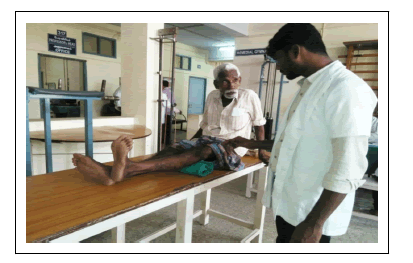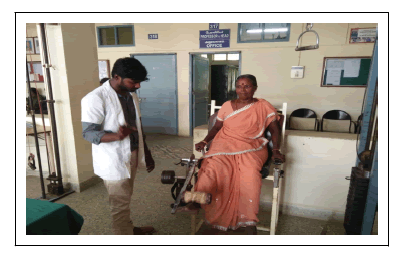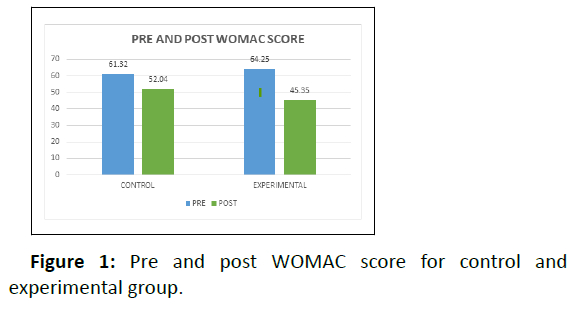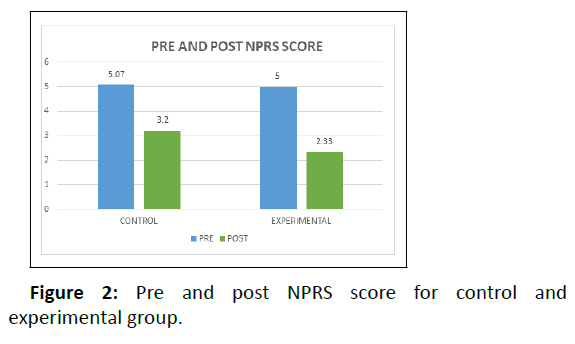Effects of Isotonic Quadriceps Resistance Training on Selective Functional Activity and Pain in Patient with Osteoarthrosis Knee
Sankar M K Sundaraganesh*
Department of Physical Medicine and Rehabilitation, Annamalai University, Rajah Muthaiah Medical College & Hospital, Chidambaram, Annamalai Nagar, India
- *Corresponding Author:
- Sankar M K Sundaraganesh
Department of Physical Medicine and Rehabilitation, Annamalai University,
Rajah Muthaiah Medical College & Hospital, Chidambaram, Annamalai Nagar,
India,
E-mail: dctrsnkr@gmail.com
Received date: July 19, 2022, Manuscript No. IPJMRHE-22-2592; Editor assigned date: July 21, 2022, PreQC No. IPJMRHE-22-2592 (PQ); Reviewed date: July 29, 2022, QC No. IPJMRHE-22-2592; Revised date: Aug 10, 2022, Manuscript No. IPJMRHE-22-2592 (R); Published date: Aug 19, 2022, DOI: 10.36648/2393-8862.6.4.18
Citation: Sundaraganesh SMK (2022) Effects of Isotonic Quadriceps Resistance Training on Selective Functional Activity and Pain in Patient with Osteoarthrosis Knee. J Med Res Health Educ Vol. 6 No.4:18
Abstract
Objective: To evaluate the effectiveness of isotonic quadriceps resistance training on selective functional activities and pain in patient with osteoarthrosis of knee.
Study Design: Experimental study.
Setting: Division of P.M. & R, R.M.M.C. &H, Annamalai University.
Methods: Thirty patients with unilateral osteoarthrosis of knee were randomly assigned in two groups (Control N=15, Experimental N=15). The patient in the both groups were underwent wax therapy for 20 minutes by using clothing method in a day. The control group underwent isometric quadriceps muscle setting exercise for a period of 10 minutes, with a brief rest in between. The experimental group underwent of pain tolerable isotonic quadriceps muscle resisted exercise by using quadriceps chair for a period of 10 minutes, with a brief rest in between.
Study Duration: 4 days in a week for 3 weeks.
Outcome Measures: Functional capacity and pain during rest were tested before and after training in both the groups by using, NPRS (Numerical Pain Rating Scale) and WOMAC SCALE (Western Ontario and McMaster university osteoarthritis index).
Results: The isometric training group scored a NPRS pain rating scale mean value of 1.87 ± 0.64 and isotonic resisted training shows a mean value of 2.67 ± 0.99 with a t value of 4.598 and a significant of p value 0.001. Also, the study revealed that the patient who received isometric training shows a WOMAC score mean difference of 9.28 ± 7.07 and isotonic resisted training shows a value of mean difference of 18.90 ± 8.07 with a t value of 3.474 and a significant of p value of 0.002. This shows that the isotonic resistance training and wax bath was highly effective in improving functional activity and reducing pain in patient with OA knee.
Conclusion: Both the training group showed a marked decrease in pain scores and increase in functional activities. When compared between the groups, the isotonic training group had a significant improvement in functional activities and pain reduction in patient with OA knee.
Introduction
OA can be defined as a condition characterized by focal areas of loss of articular cartilage within the synovial joints, associated with hypertrophy of the bone (osteophytes and subchondral bone sclerosis) and thickening of the capsule [1,2].These changes may occur as a result of an imbalance in the equilibrium between the breakdown and repair of joint tissue. Primary symptoms of OA include joint pain, stiffness and limitation of movement. Disease progression was usually slow but can ultimately lead to joint failure with pain and disability. A recent survey in India reported that the prevalence of OA in older adults more than 65 years of age was 32.6% in the rural population and 60.3% in the urban population [3]. Three major physical impairments, such as knee pain, stiffness, and decreased quadriceps strength, are highly associated with knee OA and are believed to contribute to physical disability and progression of the disease [3-6].
Individuals with osteoarthritis of the knee joint commonly display marked weakness of the quadriceps muscles, with strength deficits of 20 to 45% compared with age and gendermatched controls. Persistent quadriceps weakness was clinically important in individuals with OA as it is associated with impaired dynamic knee stability and physical function [7] and especially if you don't have a strong VMO, you may experience knee pain and nagging injuries [8]. Moreover, the quadriceps have an important protective function at the knee joint, working eccentrically during the early stance phase of gait to cushion the knee joint and acting to decelerate the limb prior to heel strike, thereby reducing impulsive loading. Weaker quadriceps has been associated with an increased rate of loading at the knee joint and recent longitudinal data have shown that greater baseline quadriceps strength may protect against incident knee pain.
There are two main factors associated with loss of quadriceps strength in patients with knee arthritis were atrophy and muscle inhibition. The quadriceps has been shown to exhibit a 12% reduction in cross sectional area representing atrophy in patients with knee arthritis. This atrophy obviously contributes to loss of strength, however inhibition of volitional control of the quadriceps has also been found. Therefore, quadriceps strength needs to be considered in the study of knee OA.
Research is still ongoing regarding investigation of the role of strengthening in the treatment of OA of the knee. In general, most of the patients with OA knee undergoing isometric training as it allow low increase in intra-articular pressure and minimal joint movement. But day to day physical activities may demand more isotonic muscle work and however there is little evidence that isometric strength will carry over to isotonic muscular function. Believing that the isotonic resisted training may have an advantage as the quadriceps have an important protective function at the knee joint by working eccentrically during the early stance phase of gait to cushion the knee joint and acting to decelerate the limb prior to heel strike, thereby reducing impulsive loading [9,10]. So, it is essential to analyze the effect of isotonic quadriceps strengthening improving functional activity and reducing pain in patient with OA knee.
Objective
To evaluate the effectiveness of isotonic quadriceps resistance training on selective functional activities and pain in patient with osteoarthrosis of knee.
Review of Literature
• Haniel J, et.al. (2015) conducted a study on effect of progressive resistance exercise on African-American male patient with radio graphic evidence of bilateral OA knee [11]. The subjects completed an eccentric strengthening regimen for 12weeks with exercise session lasted approximately 20min-30min and who shows improvements in pain, muscle morphology, muscle strength, functional performance. Hence, the authors concluded that eccentric strength training will be beneficial for patients with OA knee.
• Kevin and Anamaria (2012) evaluated the effects of progressive resistance strength training on knee biomechanics during single leg step-up in persons with mild knee OA of age group 40 to 60 years underwent program training for 8 weeks, were they completed 3 sets of 10 repetitions at each session and was a 2 minutes rest between sets [12]. Hence, the results of the study suggest that patient with OA knee shows improvements in function, pain, and other symptoms with no exacerbations following strength training.
• Joshua, Scott B et.al. (2010) had studied about progressive resistance training improves overall physical activity levels in patients with early osteoarthritis of the knee which include 171 patients( 74% women , 26% men) aged 55 years and radiographic status of grade II OA [13]. The participants met with certified physical trainers 3 times per week for 9 months with minimum of 1 day rest between training sessions. Hence, they found that OA of the knee can engage in a resistance program without sacrificing their overall MVPA levels.
• Angela, et al. (2008) had studied about strength training for treatment of osteoarthritis of the knee including eighteen studies enrolling review of 2832 subjects of age range 55-74 years. The majority of studies prescribed for 3 sets, but sets ranged from 10 to 12 repetitions were most commonly prescribed and 3 training sessions per week was most commonly prescribed but range was from 2 to 7 sessions per week [14]. The result of the study revealed that resistance training improved muscle strength and self-reported measures of pain and physical function in over 50-75% of this cohort. Also, the authors suggest that more studies to be conducted to establish dose- relationships and resistance training.
• Fransen M, Mc-Connel S (2008) had studied whether the therapeutic exercise is beneficial for people with knee OA in terms of reduced joint pain or improved physical function [15]. Hence, they found that therapeutic exercise has atleast short term benefit in terms of reduced knee pain and improved physical function for people with knee OA.
• Alan e, steven a et al. (2006) studied the effects of strength training on the incidence and progression of knee osteoarthritis which included total of 221 older adults with mean age of 69 years were randomized to strength training and range of motion exercises and they exercised 3 times per week for 12 weeks consisted of 3 sets of each exercise and sets of 8-10 repetitions [16]. Then, the authors analyzed WOMAC pain scores and reported that strength training group retained more strength and exhibited less frequent progressive JSN over 30 months than the ROM group.
• Topp R, Wooley S et al. (2002) had studied about dynamic & isometric resistance training on pain & functioning among patients with knee osteoarthritis (OA) and they found that dynamic or isometric resistance training improve functional ability and reduces knee joint pain of patients with knee OA [17].
• Hakan Gur et al. (2002) compared the effects of concentric and coupled concentric-eccentric isokinetic resistance training on functional capacity & symptoms in 23 patients with osteoarthrosis of the knee aged 41 to 75 years [18]. They were randomly assigned in 3 group were the concentric group performed 12 concentric contraction of knee extensor and flexor muscles, the concentric-eccentric group performed 6 concentric and 6 eccentric contraction of each knee muscle group, duration for 3 days a week for 8 weeks and later both the groups exhibited marked decreases in pain scores. Hence, this study reveals that strength training improves functional capacity in OA knee patients.
• Kuptniratsaikul V, Tosayanonda O et al. (2002) studied about the efficacy of a muscle exercise program in improving functional performance of the knee in patients with osteoarthritis and they reported that the strength of the quadriceps was increased and the walking distance was significantly improved [19].
• Wyatt FB, Milam S, et al. (2001) studied on the difference between an aquatic exercise program and a land-based exercise program in functional levels for patients with osteoarthrosis and they found that both exercises groups showed a significant increase in all functional levels and there were no significant differences between the two groups [20].
• Schilke JM, Johson GO et al. (1996) studied the effects of muscle-strength training programme on the functional health status of patients with osteoarthritis of the knee joint and they reported that there was a significant decrease in pain & stiffness and a significant increase in mobility [21].
• Borjesson M, Rbertson E, et al. (1996) evaluated the effects of physiotherapy on patients with medial knee osteoarthrosis and they found that after physiotherapy the ability to descend steps was improved [22].
• Fisher NM, Gresham GE, et al. (1993) studied quantitatively the effects of physical therapy on muscular and functional performance in patients with osteoarthrosis of knee and they found that the strength of the hamstrings and quadriceps was significantly increased [23]. Functionally, there were significant improvements in the ability to climb stairs, rise from a chair and walk. Walking time and pain of performing various activities decreased.
• Fisher NM, et al. studied the effects of a muscle rehabilitation program on muscle strength, endurance, speed and function for patients with OA of the knee and they found that there was a significant increase in muscle function were associated with decrease dependency, difficulty and pain [24]. There will be improvement in all functional performance.
Methodology
Study participants
30 subjects with unilateral osteoarthrosis of knee joint.
Selection Criteria
• Both male and female.
• Aged between 40 to 70 years.
• Patient with relatively constant activity level.
• Patient with moderate pain intensity of 4-6(NPRS).
• Patient who can bare resistance of minimum 1/2 kg were only included in the experimental group.
• Secondary type of osteoarthritis knee was not considered.
• Patient free of deformity of knee were only considered.
Materials required
• Quadriceps chair.
• Towel.
• Weight plates.
• Footstool.
• Stopwatch.
Methods
Treatment session
A 30 minutes treatment session comprises of 20 minutes of wax therapy and 10 minutes of corresponding exercise regimen for 4 days in a week for 3 weeks.
Wax therapy
The patient in the both groups were underwent wax therapy and it was applied over the affected knee, for a period of 20 minutes by using clothing method in a day.
Exercise therapy protocol for control group
Followed by wax therapy, the controlled group underwent 10 minutes of isometric quadriceps muscle setting exercise session.
Isometric Quadriceps Exercises
Position of the patient
Long sitting with hands at side
Technique
A role of towel was placed below the affected knee. The participant was asked to press the back of the knee downward through the towel, while dorsiflexion the ankle. Ask the patient to feel the quadriceps contraction and to maintain it for 10 seconds and then to relax for 5 seconds. One set comprises of 10 repetition and the patients were asked to do 3 sets with a brief rest between every set.

Exercise therapy protocol for experimental group
Followed by wax therapy, the experimental group underwent 10 minutes of pain tolerable isotonic quadriceps muscle resisted exercise by using Quadriceps chair.
Isotonic Quadriceps Muscle Resisted Exercise
Position of the patient
High sitting in quadriceps chair
Technique

The patient was positioned in quadriceps chair and a suitable pain tolerable weight resistance was selected. Instruction was given to the patients to perform the movement in a smooth controlled manner. They were asked to extend the knee against this resistance from 90° to 0° (concentric) and then to lower it down (eccentric work). One set comprises of 10 repetition and the patients were asked to do 3 sets with a brief rest in between every set.
Statistical Analysis
The collected data were statistically analyzed to find out the effect of isotonic resisted exercise (Table 1).
| Groups | N | Mean | SD | SEM | t-value | P-value |
|---|---|---|---|---|---|---|
| Pre test | 15 | 61.32 | 3.53 | 0.91 | 5.086 | 0.001 (S) |
| Post test | 15 | 52.04 | 6.91 | 1.79 |
Table 1: Paired sample test for Control Group (Pre and Post-test WOMAC score)
Control group shows the mean pre-test value of 61.32 ± 3.53 and post-test mean value of 52.04 ± 6.91, with a t value of 5.086 and a significant of p value 0.001.This shows the conventionally used isometric training and wax bath were significantly improved the functional activity in patient with OA Knee (Table 2).
| Groups | N | Mean | SD | SEM | t-value | P-value |
|---|---|---|---|---|---|---|
| Pre test | 15 | 64.25 | 4.46 | 1.15 | 9.075 | 0.001 (S) |
| Post test | 15 | 45.35 | 6.39 | 1.65 |
Table 2: Paired sample test for Experimental Group (Pre and Post-test WOMAC score)
Experimental group shows the mean pre-test value of 64.25 ± 4.46 and post mean value of 45.35 ± 6.39 with a ’t’ value of 9.075 and a significant of 'p' value of 0.001. This shows the experimentally used isotonic resistance training and wax bath were highly significant in improving functional activity in patient with OA knee (Table 3).
| Groups | N | Mean | SD | SEM | t-value | P-value |
|---|---|---|---|---|---|---|
| Control | 15 | 9.28 | 7.07 | 1.82 | 3.474 | 0.002 (S) |
| Experimental | 15 | 18.9 | 8.07 | 2.08 |
Table 3: Independent sample t-test for Control and Experimental Group (WOMAC score)
In the above table, the control group training shows a WOMAC score mean difference of 9.28 ± 7.07 and the experimental group training showed a value of mean 18.90 ± 8.07 with a t value of 3.474 and a significant p value of 0.002 (Figure 1). This shows the isotonic resistance training and wax bath was highly effective than the conventionally used isometric training in improving functional activity in patient with OA knee (Table 4).
The above table shows NPRS pain rating pre-test mean value of 5.07 ± 0.88 and post-test mean value of 3.20 ± 0.86 with a t value of 11.297 and a significant of p value 0.001.This shows the conventionally used isometric training and wax bath was effective in reducing pain in patient with OA knee (Table 5).
| Groups | N | Mean | SD | SEM | t-value | P-value |
|---|---|---|---|---|---|---|
| Pre test | 15 | 5.07 | 0.88 | 0.23 | 11.297 | 0.001 (S) |
| Post test | 15 | 3.2 | 0.86 | 0.22 |
Table 5: Paired sample test for NPRS Experimental Group (Pre and Post-test)
The experimental group showed a pre-test value NPRS pain rating scale mean of 5.00 ± 0.76 and post-test value of mean 2.33 ± 0.98 with a t value of 14.270 and a significant of p value 0.001.This shows the experimental used isotonic resistance training and wax bath was effective in highly improving pain in patient with OA Knee (Table 6).
| Groups | N | Mean | SD | SEM | t-value | P-value |
|---|---|---|---|---|---|---|
| Control | 15 | 1.87 | 0.64 | 0.16 | 4.598 | 0.001 (S) |
| Experimental | 15 | 2.67 | 0.99 | 0.26 |
Table 6: Independent sample t-test for NPRS Control and Experimental Group
In the above table, the control group training shows a NPRS pain rating scale mean value of 1.87 ± 0.64 and experimental group training shows a mean value of 2.67 ± 0.99 with a t value of 4.598 and a significant of p value 0.001.This shows the isotonic resistance training and wax bath was highly effective than the conventionally used isometric training in improving pain in patient with OA knee (Figure 2).
Discussion
This study was aimed to evaluate the effect of isotonic quadriceps resisted training in improving functional activity and reducing pain in patient with OA knee. Based on the selection criteria thirty patients with primary OA knee were randomly recruited for this study and they randomly assigned in control (n=15) and experimental (n=15) groups. All the subjects were informed about the possible risk and discomfort during therapy and an oral informed consent was obtained. None of the subjects in the groups complained pain during treatment session and no one stopped the training during 3 weeks of training and they completed the whole training schedule.
Before starting the treatment programme, the initial level of functional capacity and knee pain of the patient were assessed by using WOMAC scale and NPRS. The study didn't attempt to assess the objective muscle strength by Repetition Maximum (RM) as this procedure may induce pain. All the patient were attended a 4 treatment session in a week for 3 weeks. Initially, both the groups underwent wax therapy and it was applied over the affected knee, for a period of 20 minutes by using clothing method in a day. Followed by wax therapy, the controlled groups will undergo isometric quadriceps muscle setting exercise (15 Repetition) and the experimental group will undergo 10 min of pain tolerable isotonic quadriceps muscle resisted exercise in a range of 90° to 0° knee extension by using quadriceps chair. We didn’t attempt strenuous strength exercise programme presuming that they might be harmful to knee, another consent might be the pain could limit to the outcome [18]. At the same time this protocol appeared to have a positive physiological adaptation to isotonic resisted training without an exacerbation of his knee OA symptoms.
The study result reveals that both the control and experimental group showed a significant improvement in functional activity and reduction of pain. In functional activity the control group attained a WOMAC pre-test value of 61.32 ± 3.53 and post-test mean value of 52.04 ± 6.91, with a t value of 5.086 and a significant of p value 0.001. And the experimental group attained pre-test value of 64.25 ± 4.46 and post mean value of 45.35 ± 6.39 with a 't' value of 9.075 and a significant of 'p' value of 0.001.Thus, the both the groups showed a significant improvement in functional activity. On pain reduction the control group showed NPRS pain rating pre-test mean value of 5.07 ± 0.88 and post-test mean value of 3.20 ± 0.86 with a t value of 11.297 and a significant of p value 0.001. And the experimental group showed a pre-test value NPRS pain rating scale mean of 5.00 ± 0.76 and post-test value of mean 0.47 ± 0.99 with a t value of 4.010 and a significant of p value 0.001. Thus, the both groups showed a significant reduction of pain. Our findings concur with those obtained in previous studies that have demonstrated the benefits of isometric exercise in strength training, while compared the effect of isokinetic training in patients with osteoarthritis of the knee showed significant improvement in muscle strength at the end of the trial [25,26].
While comparing the WOMAC score between the patient groups, the control group training shows a value of the pre and post mean difference of 9.28 ± 7.07 and experimental group training shows a value of the pre and post mean difference of 18.90±8.07 with a t value of 3.474 and a significant of p value of 0.002. This shows that patient recorded the largest improve in the WOMAC score, and improves favorable response to isotonic resisted exercise when compared with conventionally used isometric training. On comparing pain reduction, the control group training shows a NPRS pain rating scale mean value of 1.87 ± 0.64 and experimental group training shows a mean value of 2.67 ± 0.99 with a t value of 4.598 and a significant of p value 0.001.This shows the experimentally used isotonic resistance training and wax bath was effective in highly reducing pain in patient with OA Knee. The isotonic group showed a significant improvement. This trend is similar to the previous study showed that the patients with OA in each treated by isotonic exercise had the greatest effect on pain reduction after treatment, and they suggest isotonic exercise was suggested for initial strengthening in patients with OA knee pain [27].
In summary both training group showed marked decrease in pain scores and increase in functional capacity. While comparing between the groups the experimentally used isotonic resistance training and wax bath had a significant improvement in functional capacity and pain reduction.
However, in this study the improvements were in selfreported measure of pain and functions, these improvements might not be related to strong specific bio-mechanical adaptations and muscle strength. So, there is a need for the future trial with a specific objective evaluation, serial standardized radiography examination, and larger sample sizes to confirm these results.
Conclusion
Both the training groups showed a marked decrease of pain and increase in functional capacity. On comparing between the groups, the isotonic training group has a better influence on improving functional capacity and pain reduction. So, the study concluded by delivering the isotonic resisted exercise of quadriceps without over stressing the joints was a heavy element for successful program.
References
- Lawrence RC, Helmick CG, Arnett FC, Deyo RA, Felson Dt, et al. (1998) Estimates of the prevalence of arthritis and selected musculoskeletal disorders in the United States. Arthritis Rheum 41: 778-799.
[Crossref], [Google Scholar], [Indexed]
- Zhang Y, Xu L, Nevitt MC, Aliabadi P, Yu W, et al. (2001) Comparison of the prevalence of knee osteoarthritis between the elderly Chinese population in Beijing and whites in the United States: The Beijing Osteoarthritis Study. Arthritis Rheum 44: 2065-2071.
[Crossref], [Google Scholar], [Indexed]
- Estimates of the prevalence of arthritis and selected musculoskeletal disorders in the United States
- Slemenda C, Brandt KD, Heilman DK, Mazzuca S, Braunstein EM, et al. (1997) Quadriceps weakness and osteoarthritis of the knee. Ann Intern Med 127: 97–104.
[Crossref], [Google Scholar], [Indexed]
- Hurley MV, Scott DL, Rees J, Newham DJ (1997) Sensorimotor changes and functional performance in patients with knee osteoarthritis. Ann Rheum Dis 56: 641–648.
[Crossref], [Google Scholar], [Indexed]
- McAlindon TE, Cooper C, Kirwan JR, Dieppe PA (1993) Determinants of disability in osteoarthritis of the knee. Ann Rheum Dis 52: 258–262.
[Crossref], [Google Scholar], [Indexed]
- Rice DA, McNair PJ, Lewis GN (2011) Mechanisms of quadriceps muscle weakness in knee joint osteoarthritis: The effects of prolonged vibration on torque and muscle activation in osteoarthritic and healthy control subjects. Arth Res Thera 13: p151.
[Crossref], [Google Scholar], [Indexed]
- Sheehan F, Borotikar BS, Behnam AJ, Alter KE (2013) Alterations in in vivo knee joint kinematics following a femoral nerve branch block of the vastus medialis: Implications for patellofemoral pain syndrome. Clinical Biomechanics 6: 525-531.
[Crossref], [Google Scholar], [Indexed]
- Brandt KD, Dieppe P, Radin EL (2008) Etiopathogenesis of osteoarthritis. RheumDis Clin North Am 34: 531-559.
[Crossref], [Google Scholar], [Indexed]
- Jefferson RJ, Collins JJ, Whittle MW, Radin EL, O’Connor JJ (1990) The role of the quadriceps in controlling impulsive forces around heel strike. Proc InstMech Eng H 204:21-28.
[Crossref], [Google Scholar], [Indexed]
- Hernandez HJ, Mclntosh V, Leland A, Harris-Love MO (2015) Progressive resistance exercise with eccentric loading for the management of knee osteoarthritis. Frontiers in medicine 2: p55.
- McQuade KJ, Oliveira AS (2011) Effects of progressive resistance strength training on knee biomechanics during single leg step-up in persons with mild knee osteoarthritis. Clin Biomech 26: 741-748.
[Crossref], [Google Scholar], [Indexed]
- Farr JN, Going SB, McKnight PE, Kasle S, Cussler EC, et al. (2010) Progressive resistance training improves overall physical activity levels in patient with early osteoarthritis of the knee: A Randomized controlled trial. Ame phy therAsso Phys ther 90: 356-366.
[Crossref], [Google Scholar], [Indexed]
- Lange AK, vanwanseele B, Singh MAF (2008) Strength training for treatment of osteoarthritis of the knee: A systematic Review patient. Arth & Rheu 59: 1488-1494.
[Crossref], [Google Scholar], [Indexed]
- Fransen M, McConnell S, Harmer AR, Esch MV, Simic M (2008) Exercise for osteoarthritis of the knee. Cochrane database of systematic reviews 4: CD004376.
[Crossref], [Google Scholar], [Indexed]
- Mikesky AE, Mazzuca SA, kenneth d, Perkins SM, Damush T (2006) Effects of strength training on the incidence and progression of knee osteoarthritis. Arthr rheu 55: 690-699.
[Crossref], [Google Scholar], [Indexed]
- Topp R, Woolley S, Hornyak J, Khuder S, Kahaleh B (2002) The effect of dynamic versus isometric resistance training on pain and functioning among adults with osteoarthritis of knee. Arch phys Med Rehabil 83:1187-1195.
[Crossref], [Google Scholar], [Indexed]
- Gur H, Cakfin N, Akova B, Okay E, Kucukoglu S (2002) Concentric versus combined Concentric-Eccentric isokinetic training: Effects on functional capacity and symptoms in patients with osteoarthrosis of the knee. Arch Phys Med Rehabil 83:308-316.
[Crossref], [Google Scholar], [Indexed]
- Kuptniratsaikul V, Tosayanonda O, Nilganuwong S, Thamalikitkul V (2002) The efficacy of a muscle exercise program to improve functional performance of the knee in patients with osteoarthritis. J Med Assoc Thai 85: 33-40.
[Crossref], [Google Scholar], [Indexed]
- Wyatt FB, Milam S, Manske RC, Deere R (2001) The effects of aquatic and traditional exercise programs on persons with knee osteoarthritis. J strength Cond Res 15: 337-340.
[Crossref], [Google Scholar], [Indexed]
- Schilke IM, Johnson GO, Housh TJ, O'Dell JR (1996) Effects of muscle-strength training on the functional status of patients with osteoarthritis of the knee joint. Nurs Res 45: 68-72.
[Crossref], [Google Scholar], [Indexed]
- Borjesson M, Robertson E, Weidenhielm L, Mattsson E, Olsson E (1996) Physiotherapy in knee osteoarthrosis: Effect on pain and walking. Physiother Res Int 1: 89-97.
[Crossref], [Google Scholar], [Indexed]
- Fisher NM, Gresham GE, Abrams M, Hicks J, Horrigan D, et al. (1993) Quantitative effects of physical therapy on muscular and functional performance in subjects with osteoarthritis of the knees. Arch Phys Med Rehabil 74: 840-847.
[Crossref], [Google Scholar], [Indexed]
- Fisher NM, Pendergast DR, Gresham GE, Calkins E (1991) Muscle Rehabilitation: It's effect on muscular and functional performance of patients with knee osteoarthritis. Arch Phys Med Rehabil 72: 367-374.
[Crossref], [Google Scholar], [Indexed]
- Zhang W, Moskowitz R, Nuki G, Abramson S, Altman R, et al. (2008) OARSI recommendations for the management of hip and knee osteoarthritis, Part II: OARSI evidence-based, expert consensus guidelines. Osteoarthritis Cartilage 16: 137–162.
[Crossref], [Google Scholar], [Indexed]
- Van Baar ME, Assedelft WJJ, Dekker J, Oostedorp RAB, Bijlsma JWJ (1999) Effectiveness of exercise therapy in patients with osteoarthritis of the hip or knee. Arthritis Rheum 42: 1361–1369.
[Crossref], [Google Scholar], [Indexed]
- Huang MH, Lin YS, Yang RC, Lee CL (2003) A comparison of various therapeutic exercises on the functional status of patients with knee osteoarthritis. Semin Arthritis Rheum 32: 398-406.
[Crossref], [Google Scholar], [Indexed]
Open Access Journals
- Aquaculture & Veterinary Science
- Chemistry & Chemical Sciences
- Clinical Sciences
- Engineering
- General Science
- Genetics & Molecular Biology
- Health Care & Nursing
- Immunology & Microbiology
- Materials Science
- Mathematics & Physics
- Medical Sciences
- Neurology & Psychiatry
- Oncology & Cancer Science
- Pharmaceutical Sciences


